Words by Paul | Photos by Jacque
In the book Along the Ganges, Ilija Trojanow describes his trip from the source of the Ganges River to the sea. During the voyage, Ilija learns about the history and mythology that surround the Ganges, as well as discovering the modern-day pollution issues facing the river. His tales of the river as both holy sanctuary and pollution dumping ground were fascinating; Jacque and I needed to see life along the river for ourselves. Varanasi rose to the top of our Indian destination list.

Morning chai tea on the train
Varanasi is a city on the Ganges about 500 miles southeast of New Delhi. We took the Farakka Express overnight – the wonderful train network in India is a convenient leftover of British colonialism, unlike the ridiculous bureaucracy – arriving 17 hours after we left New Delhi. (Don’t believe the hype: travelling by train in AC2 class is perfectly clean and comfortable. In the mood for a real Indian experience? Take sleeper class.) As with any train station in India, or indeed any train or bus station in most of Asia, we were greeted at Varanasi Junction by mass chaos. Normally, we would have figured out our own transportation to the guest house; we’ve become adept at managing the gauntlet of taxi and tuk-tuk drivers. In this case, though, we smartly arranged pick up with our guest house. We were thankful for our guide in the labyrinth of Varanasi’s alleyways.
Ah, the alleyways of Varanasi. No single place in India embodies the feeling of the country so completely as these alleyways. They’re consistently crowded and the crowd is pushy, the pushiest being, of course, the old women. The surface of the alley is consistently covered in shit. The cows and dogs, who are usually the ones shitting, roam freely everywhere. Food vendors chuck kachoris at noisy patrons who chuck 30 rupees back at them. Children run everywhere, happy against all odds, begging for a photo. Every once in a while, a group of men comes by with a covered body, chanting a prayer as they pass. And somehow moto drivers weave their way through the throng, honking and revving the engine. Describing himself as a common person, one of our fellow passengers on the train said: “There are a lot of common people in India.” Nowhere is this statement more obvious than the alleyways of Varanasi.


The chaos in the alleyways is due to Varanasi’s status as one of the holiest cities in India. According to Hindu mythology, Varanasi was founded by the god Shiva. It is incredibly popular as a destination for devout Hindus; they believe it’s auspicious to die in Varanasi, then be cremated and placed in the Ganges River. The last journey of many who are near death is the pilgrimage to Varanasi. All along the river, there are ghats, a series of wide steps leading into the water. People come to the ghats to bathe and celebrate, but also to die: two of the ghats – there are about 100 in total – are used for cremation. The children and loved ones of the deceased shave their heads, and the oldest son applies the first fire to the body. Although most Hindus are cremated, holy men, children, pregnant women, and those who die from a snake bite are considered pure. Their bodies are placed directly in the Ganges.
The ashes and bodies of the deceased – there are three or more fires on both burning ghats all hours of the day and night – contribute to the incredible levels of pollution in the Ganges. It is far from the only source of pollution. Raw sewage flows into the river in many places, probably the single biggest pollution issue on the Ganges. Those who live in Varanasi throw their plastic bags full of garbage directly into the river. In an astonishing act of doublethink, bathing in the Ganges is still considered purifying. Entire families bathe in the mornings at the ghats, splashing themselves and taking a drink of the water downriver from where their neighbor tossed his trash. For all its holiness, the Ganges is treated with what we consider extreme disrespect.
Despite the nearness to death and the dirtiness of the river, Varanasi is truly a city of celebration. Our first night, we went to the main ghat, Dasaswamedh. Several young men were playing drums near the water, while a packed crowd lined the steps of the ghat. An old gentleman weaved his way through the crowd. He suddenly appeared in front of us. “Festival,” he said flatly, then roughly applied a spot of red paint to our foreheads. I expected that he would ask for money – a fact of life for foreigners in India – but he moved along. Behind the drummers, a throng of boats on the Ganges jockeyed for position, trying to get the passengers a clear view of the proceedings. We watched the young men play the drums, the crowd jostling us incessantly, until the music stopped.
The celebration was one of five leading up to Dev Deepawali the next day. The festival is less well-known than Diwali, which Hindus celebrate 15 days earlier, and is only celebrated in Varanasi. During the day, an unseen army of people lay out thousands upon thousands of small, clay dishes upon the steps of all the ghats in perfect rows. Within the dish is oil and a small wick. As darkness descends, they are all lit – again, by an unseen army of people – illuminating the steps for the gods to bathe in the Ganges. The lamps lend a magical light to the city; its usual grime disappears under the flickering lights, leaving behind only the romantic notion of the Ganges held by the Hindus.
After Dev Deepawali, many of the visitors evaporated. For Indians and Westerners alike, the festivals and cremations on the ghats are the only attraction. Beyond the ghats, though, there is an entire city full of life. In our usual fashion, we searched out a local gym called Scorpio Gym, a treasure of a place. The owner wanted to know about our workout regimen back home, like any good meathead, even though he spoke little English. The manager of a small restaurant chatted with us on our first visit and remembered us the next time. He even charged us the non-tourist price for our return visit. A scowling but skilled local barber gave me a fantastic haircut followed by a ridiculous face “massage” that involved a dental-floss-like scraping of my entire face. (Jacque said it made me look younger, so maybe there’s something to it?) Walking to a grocery store, we ran across a friendly youngster earning his MFA in English who enjoyed talking about travel. The children in our alleyway were constantly laughing and playing, ecstatic to see the foreigners every day. “Hello! Hello!” they called to us, begging for us to pick them up and spin them around. Though there are the usual touts and scam artists in Varanasi, the people of the city are happy, kind, skillful, and curious.
Despite its popularity for Indian and foreign visitors and the resulting crowds, Varanasi stands as one of our favorite places in the world. The ghats of Varanasi are clearly the primary attraction and well worth the long train ride, particularly during a festival. The cycle of life and death embodied in the cremations and celebrations is not to be missed. To simply visit the ghats would be a shame, though. The city has more to offer to the casual wanderer, from its tucked-away lassi shops to the alleyway cows munching on trash, from the pre-teens selling their drawings as temporary tattoos to the painted holy men on every ghat, from the newspaper photographers who just “want a picture of a foreigner holding a candle!” to the women with sharp elbows in a crowd. We went to Varanasi for a chance to view the Hindu holy place to die on the Ganges, but the city drew us in beyond our expectation. It’s a city that embodies India: challenging and rewarding, lively and exotic. It’s a city with strong ties to ancient Hindu tradition that manages to highlight the issues that face modern India. It’s a city with many paradoxes – like India itself – with one paradox at its core: for a place where people come to die, it’s awfully full of life.
Hey! We love hearing from you… click on the little “plus” icon below and to the right to leave us a comment :)

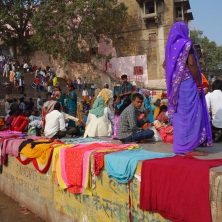














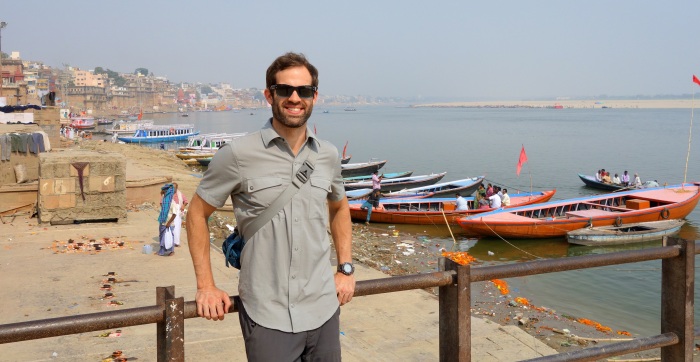

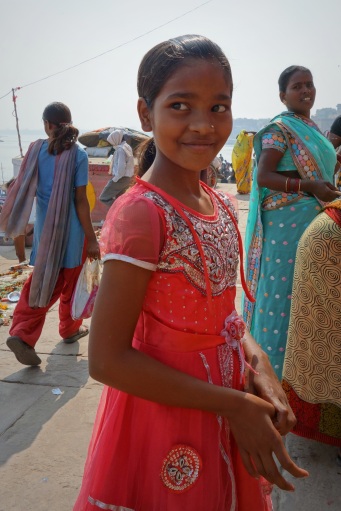





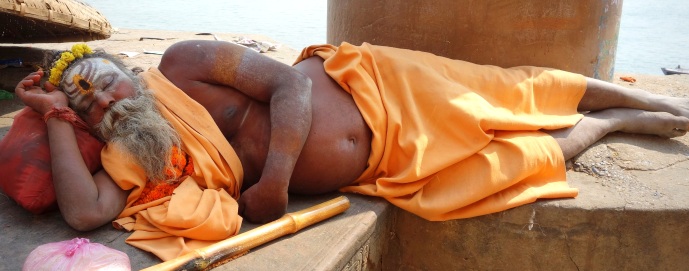

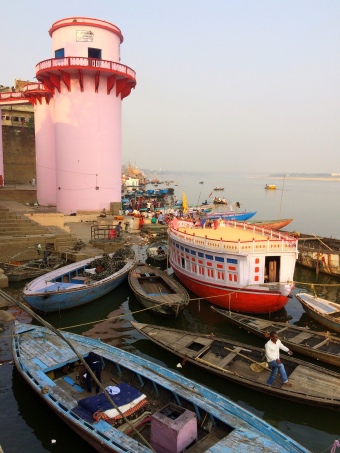




Wow, what a fascinating place. Quite the opportunity to experience the human condition. The photos really help tell the story. :-)
LikeLiked by 1 person
Love your text and pics.Hope you Publish it for your future progeny.What an adventure!
Lots of love, Aunt Elaine Cost
LikeLiked by 1 person
Excellent post! As an environmental wonk, I’m pretty appalled by the treatment of the Ganges, but maybe they have the right idea somehow… just not clear on how that might work. The city residents sound like they enjoy the life, as is!
-Pops
LikeLike
The book I mentioned, Along the Ganges, talks quite a bit about why things are as bad as they are. It has partially to do with the terrible bureaucracy endemic in the country: nothing can get fixed in any reasonable time scale.
LikeLike
Hope this reaches you all. I cannot seem to get into the comment section of your blog.
Anyway, I am Sherry, of Don and Sherry, from Seattle, and we met in Varanasi in November.
Just had to tell you how much I liked reading your post. Made me like Varanasi more than I did while I was visiting there. You captured it so beautifully.
And am also enjoying all the rest of your blog postings. Glad all is going so well.
Sherry
Sent from my iPad
>
LikeLike
Good to hear from you, Sherry! It was a challenging place, wasn’t it? Kind of like India in its entirety. Thanks for reading!
LikeLike
Yet another poignant and beautiful view of a unique part of the world via your excellent words and photos. Thanks to you both! Your line, ‘Children run everywhere, happy against all odds, begging for a photo,’ is such a good reminder about our lives here at home.
LikeLike